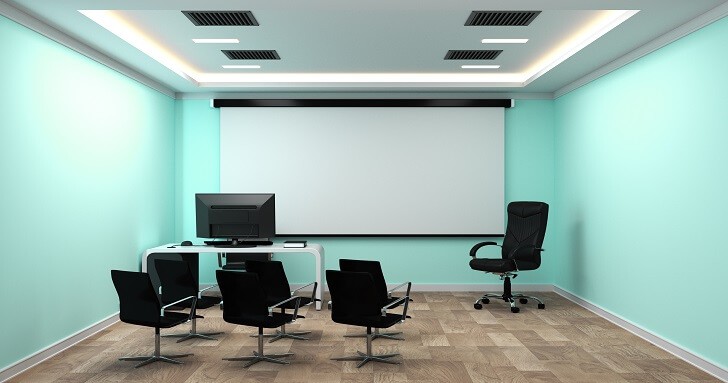Choosing the right projector screen is important as it plays a big role in producing the desired picture from the projector you are using.
If you want a quality picture, projection on the projector screen is far much better than if you project directly on the wall. The best projector screen usually depends on what you prefer and the distance of viewing. It is recommended that a viewing distance should be 1-1/2 times the diagonal of the screen for a given HD projector and 1 times the diagonal of the screen of a 4K.
In a nutshell, special ambient light rejecting projector screens can give a crisp, colourful and quality image even when there are lights in the room. Screens which are acoustically transparent allow sound to pass through and speakers can be placed behind it. Portable outdoor screens on the other hand give the user the easiest set up to produce sharp and vivid images.
Why should you use projector screen?
Projector screen is preferred as it provides a smooth, crisp image. This is because the material on the screen is vinyl and there are additions of special coatings so that it changes the way the projector’s light reflects back to viewers.
Projector screen sizes
When it comes to projector screens, space is the determining factor. It is important to note that when you project a large image can give a picture that has less optimum brightness. The size of the room determines the projector screen size you need. Generally, a projector that is 1080p HD requires a viewing distance of 1-1/2 times the diagonal of the screen. The other approach you can use to know the size of projector screen in your room is multiplying the viewing height of the screen by 3. For the case of 4K Ultra HD projector, you can view it at one times the screen diagonal.
Basic projector screen types
There are generally two types of projector screen: fixed-frame and retractable. Retractable projector screens can be found to be either manual or motorized. Fixed projector screens stay at a particular position and need enough space.
Fixed frame
Fixed frames are usually found in dedicated theatres as they require dedicated empty wall space. The advantage of using fixed frame screen is that, first, they are affordable and second, owing to the fact that they don’t roll up-and-down, they can stay in the upright and tight position to provide a quality smooth image. Also, fixed frame screens are easier to install and have great system integration standpoint.
Most fixed frame projector screens are designed with a thick frame which is usually in black velour. The black velour thick frame helps to improve the image contrast. Also, the black frame borders help to perfectly set your projector and make the image fit in the screen. It also absorbs any image from projection that gets on it. Image projection on screen projector should be done precisely to fit in the screen and not overspill on the frame.
Fixed-frame screens can be shipped either when they are fully assembled or unassembled which require you to fix them by yourself. They are however, not hard to assemble and install as they only need few basic hand tools.
Retractable projector screens
Retractable screens are slightly expensive compared to fixed-frame ones. Besides, they are a bit complicated to install. They are either motorized screens or manual.
Motorized
Motorized retractable projector screen is the best for people who use their living room in many ways. As opposed to fixed-frame screens, motorized screens allow you to use the wall space for other things when you are not watching. It is a roll up screen built with a powerful electric motor which rolls the screen to required position when you press the button.
When installed, it remains its position until the time you want to use it. They are disadvantaged by the fact that they are non-tensioned: due to them being occasionally being rolled up, they sometimes ripple and become imperfect to provide the desired picture quality.
Manual
This is the cheapest and easy to install. It has a spring-and-roller mechanism that rolls and unrolls the screen. They are occasionally used in public places like schools and other institutions. They can also be used for a home theater if you are unable to buy fixed-frame.
How to choose the right screen material
Screen material should be considered after you are done with the screen type and size. It is important to choose the right material that will work well for your projector and room. The screen material is usually gain, color and texture.
There are basically three factors one can find important when choosing a projector screen material that best suits your projector and the room. You can also look for Pyle projectors reviews for the best projector.
Screen Gain
Screen gain is what affects the brightness of the image. When the gain screen is higher, the images produced will be brighter. Screen gain is basically the amount of the projector’s light that reflects back to the viewers.
Screen Color
Color is an important factor to consider as it guides you on picking the right match of projector screen for your projector. Usually, screens come in white or shades of gray. Gray screens, also known as high contrast, are recommended because they tend to increase contrast while providing deeper blacks. Powerful projectors work well on gray screens so that they can cover up the darker whites and light colors.
White screens on the other hand are industry standard as a result of being brighter.
Screen Texture
This is another important factor that can’t be ignored. Most screens, if not all, give the details in HD video which is up to 1080p. However, there are screens which are finer in texture and are perfect when used with 4K projectors. Screen texture comes in when you are using 4K to produce a finer grit so that all the detail and depth can be shown.

